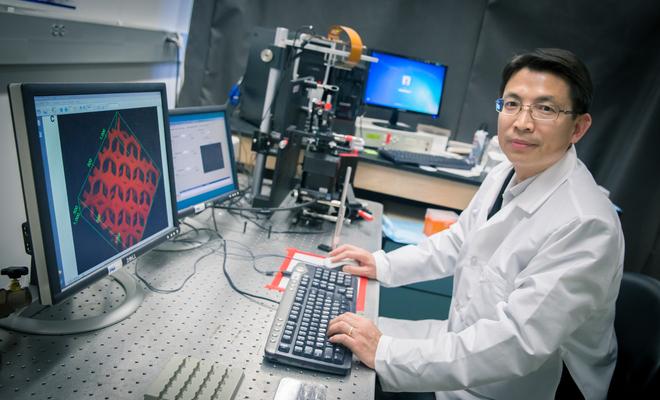University of California San Diego’s 3D Printed Liver Tissue May Be the Closest We’ve Gotten to a Real Printed Liver
 While scientists have been working on 3D printing all types of human tissue, there’s been a particular focus on the liver – for good reason. The organ plays a critical role in filtering toxins, breaking down fats, and producing vital proteins; when something goes wrong with the liver, the entire body is in serious trouble. The first company that comes to mind in terms of 3D printed liver tissue is Organovo; their exVive 3D printed liver tissue has revolutionized pharmaceutical drug testing and been a major financial success for the company. But other researchers have been steadily working on improving printed liver tissue, and the University of California, San Diego has just announced the development of a new tissue that closely mimics the structure and function of a real human liver.
While scientists have been working on 3D printing all types of human tissue, there’s been a particular focus on the liver – for good reason. The organ plays a critical role in filtering toxins, breaking down fats, and producing vital proteins; when something goes wrong with the liver, the entire body is in serious trouble. The first company that comes to mind in terms of 3D printed liver tissue is Organovo; their exVive 3D printed liver tissue has revolutionized pharmaceutical drug testing and been a major financial success for the company. But other researchers have been steadily working on improving printed liver tissue, and the University of California, San Diego has just announced the development of a new tissue that closely mimics the structure and function of a real human liver.
One of the most interesting things about bioprinting is that every research team working on it goes about it in a slightly – or dramatically – different way. The method used by UC San Diego was developed in the lab of Dr. Shaochen Chen, a professor of nanoengineering who specializes in bioprinting. The process involves taking stem cells from the skin of a patient and combining them with supporting endothelial and mesenchymal cells. The stem cells are pluripotent, meaning that they are capable of developing into several different types of tissue, and the fact that they’re taken from the patient’s skin means that no invasive procedures are needed to take actual liver cells.
The combined cells are printed into 3×3 millimeter square structures that are only 200 micrometers thick, in a process that takes only seconds – other forms of bioprinting generally take hours. The structures are cultured in vitro for about three weeks, allowing them to grow into tissue. When the research team tested the liver tissue, they found that it was capable of maintaining key liver functions, such as albumin secretion and urea production, for a longer period of time than existing liver models. It also produced higher levels of an enzyme that plays a major role in metabolizing many drugs.
“The liver is unique in that it receives a dual blood supply with different pressures and chemical constituents,” said Shu Chien, professor of medicine and bioengineering, who co-authored the study. “Our model has the potential of reproducing this intricate blood supply system, thus providing unprecedented understanding of the complex coupling between circulation and metabolic functions of the liver in health and disease.”
UC San Diego’s liver tissue has come closer than any other liver model in terms of replicating the diverse cell makeup and complex architecture of a real liver. This is very promising for pharmaceutical trials. According to Dr. Chen, it typically takes about 12 years and $1.8 billion to get a drug to the point of being approved by the FDA. 90% of drugs don’t pass animal or human clinical trials, so it’s back to the drawing board for drug companies. With 3D printed tissue that so closely mimics the function of a real human liver, pharmaceutical companies can begin doing pilot studies right away and narrowing the field down to the most promising drugs well before they ever get to human clinical trials.
“The liver tissue constructed by this novel 3D printing technology will also be extremely useful in reproducing in vitro disease models such as hepatitis, cirrhosis, and cancer,” added Chien. “Such realistic models will be invaluable for the study of the pathophysiology and metabolic abnormalities in these diseases and the efficacy of drug therapies.”
Using stem cells taken directly from the patient also means that drug testing can be targeted specifically towards individuals, and the research team hopes that their method could eventually lead to the 3D printing of patient-specific organs. You can access the full study here. Discuss in the 3D Printed Liver Tissue forum over at 3DPB.com.
Subscribe to Our Email Newsletter
Stay up-to-date on all the latest news from the 3D printing industry and receive information and offers from third party vendors.
You May Also Like
Creality Begins Selling HALOT-MAGE S: Setting New Standards in Precision 3D Printing
Creality, a leading innovator in consumer-grade 3D printing technology, proudly introduces the HALOT-MAGE S, the latest breakthrough in high-resolution 3D printing. With its cutting-edge features and user-centric design, the HALOT-MAGE...
Farsoon Showcases Comprehensive 3D Printing Solutions, Automation, and More at TCT Asia
This year’s TCT Asia event showcased just how much the Asian additive manufacturing (AM) market has grown, with Eplus3D’s 64-laser metal 3D printer alone acting as a synecdoche for China’s...
Creality Launches Ender-3 V3 Plus: Bigger CoreXZ for Unprecedented Performance
Embracing a journey of innovation and excellence, Creality’s Ender-3 series has established a distinguished path in the field of 3D printing. From the entry-level Ender-3 V3 SE to the feature-rich...
Laser Wars: Eplus3D Unveils Metal 3D Printer with up to 64 Lasers
Now that the laser wars in the powder bed fusion (PBF) space have, for the most part, moved to China, original equipment manufacturers (OEMs) there are in fierce competition. Eplus3D...



































